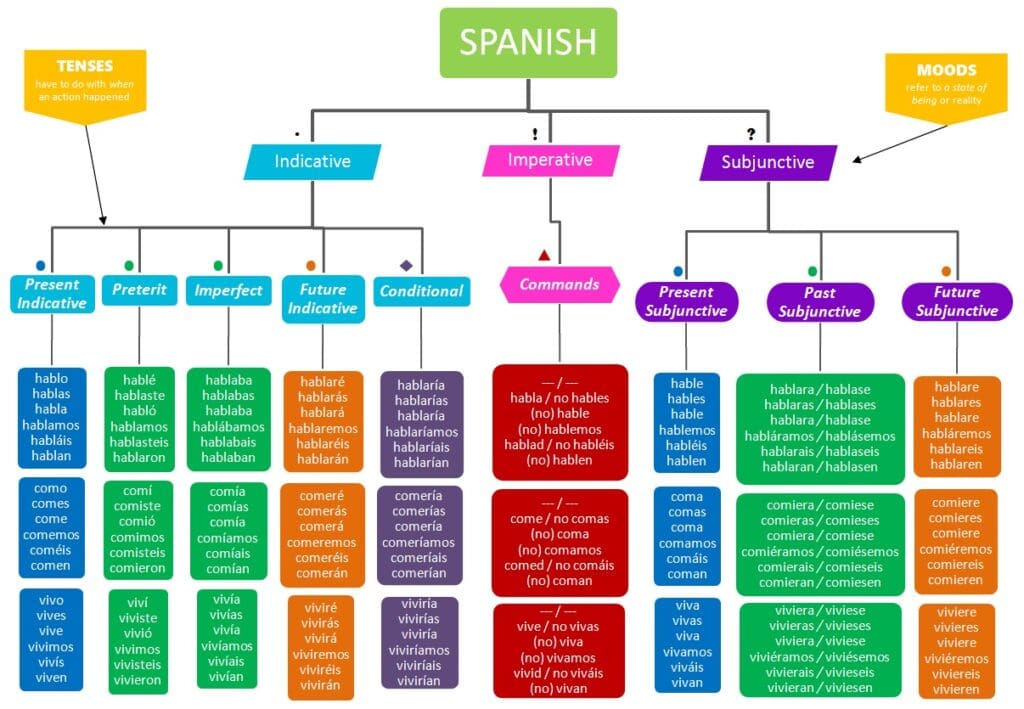Spanish is a notoriously tricky language. Even native Spanish speakers admit that it’s challenging and often agree that English is a simpler language by comparison! Spanish features moods, tenses, and conjugations that don’t even exist in English, so it’s no wonder we find it difficult to wrap our heads around this whimsical fourth dimension we call español.
In this blog, we’ll help you understand the tenses and moods in Spanish and how to apply them in your conversations.


Want to learn Spanish? We can help you! Visit our check our Spanish Courses in Malaga or Learn Spanish Online
Moods
First, let’s discuss “moods.” Moods in Spanish are not like those in English, i.e., happy mood, sad mood. A mood in Spanish is either a fact, an opinion (desires, doubts, etc.), or a command. Moods change the way a word is conjugated. It’s essential not to confuse moods with tenses, as they are two entirely different concepts.


There are three moods in Spanish:
1. Indicative Mood / El Indicativo
The Spanish indicative mood (el indicativo) is used to talk about actions, events, or states that are considered facts or true. The indicative mood is similar to the typical conjugation of verbs in English.
For example: John sleeps a lot! John duerme mucho!
2. Subjunctive Mood / El Subjuntivo
The subjunctive mood (el subjuntivo) is used to express desires, doubts, wishes, conjectures, and possibilities.
For example, in English, if we wanted to express an opinion, we would say: It’s strange that John makes paella.
If the subjunctive mood didn’t exist, that sentence in the Spanish indicative form would be: Es raro que John hace paella.
However, the subjunctive does exist, so the verb is conjugated as follows: Es raro que John haga paella.
3. Imperative Mood
The imperative mood is used to give commands. It can be a bit tricky because if you’re commanding someone to do something (positive), the verb conjugates one way; if you’re commanding someone not to do something (negative), it conjugates another way.
For example: John, don’t burn the kitchen!
If the imperative didn’t exist and it were like English, it would look like: John, no quemas la cocina!
But it does exist, so it changes to: John, no quemes la cocina!
Please note that this is conjugated in the “you” / “tú” form. In Argentina (and some other Latin American countries), they use “vos” for “you.” Most other countries use “tú,” meaning “you.” In Argentina, the “vos” imperative form would be different.
Also Read: How to Dominate the Subjunctive: Full Guide to Subjuntivo (vamospanish.com)
Tenses
A tense refers to when an action takes place. You can have a mood, like the subjunctive, and it can occur in the past or present (so a different mood and tense).
There are three primary tenses in Spanish:
1. The Present (and Present Continuous)
- The present: a habit or a general fact. Every Tuesday, John makes paella. Cada martes, John hace paella.
- The present continuous: if the action is happening in the moment or continuously. John is making paella. John está haciendo paella.
The present tense can be both in the indicative and subjunctive moods.
- Indicative: John eats a lot of Peruvian food. John come mucha comida peruana.
- Subjunctive: (opinion, desire, doubt, etc.) I don’t think John’s car is very good. No creo que el auto de John sea muy bueno
Examples:
| Mood/Tense | Use | Example |
|---|---|---|
| Indicative Present | Facts and habitual actions | John sleeps a lot: “John duerme mucho.” |
| Indicative Present Continuous | Action in progress in the moment | John is making paella: “John está haciendo paella.” |
| Indicative Past | Completed actions in the past | John made paella yesterday: “John hizo paella ayer.” |
| Indicative Future | Actions that will happen in the future | John will make paella tomorrow: “John hará paella mañana.” |
| Subjunctive Present | Expressing desires, doubts, wishes, conjectures, and possibilities | I don’t think John’s car is very good: “No creo que el auto de John sea muy bueno.” |
| Subjunctive Past | Expressing hypothetical or contrary-to-fact situations in the past | If John had made the paella, it would have been delicious: “Si John hubiera hecho la paella, habría sido deliciosa.” |
| Subjunctive Imperfect | Expressing unlikely or uncertain situations in the past | If I were rich, I would travel the world: “Si fuera rico, viajaría por todo el mundo.” |
| Imperative Affirmative | Giving commands (positive) | John, make the paella: “John, haz la paella.” |
| Imperative Negative | Giving commands (negative) | John, don’t burn the kitchen: “John, no quemes la cocina.” |




